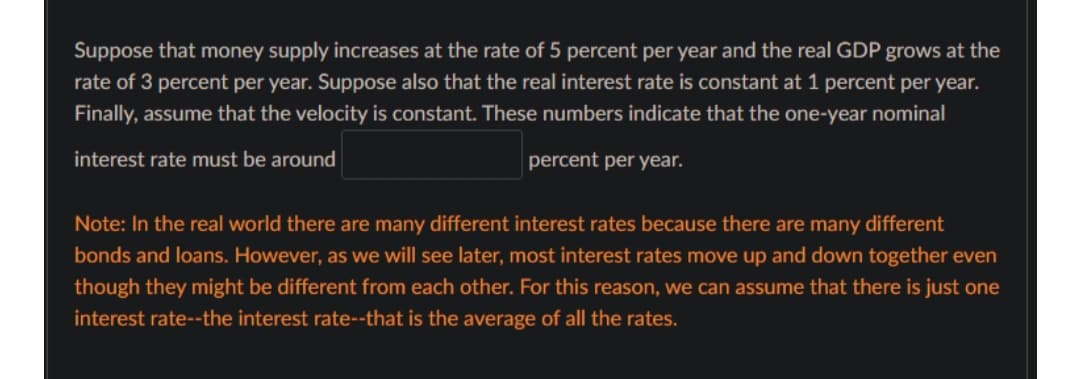Suppose that money supply increases at the rate of 5 percent per year and the real GDP grows at the rate of 3 percent per year. Suppose also that the real interest rate is constant at 1 percent per year. Finally, assume that the velocity is constant. These numbers indicate that the one-year nominal interest rate must be around percent per year. Note: In the real world there are many different interest rates because there are many different bonds and loans. However, as we will see later, most interest rates move up and down together even though they might be different from each other For this reason we can assume that there is just one
Suppose that money supply increases at the rate of 5 percent per year and the real GDP grows at the rate of 3 percent per year. Suppose also that the real interest rate is constant at 1 percent per year. Finally, assume that the velocity is constant. These numbers indicate that the one-year nominal interest rate must be around percent per year. Note: In the real world there are many different interest rates because there are many different bonds and loans. However, as we will see later, most interest rates move up and down together even though they might be different from each other For this reason we can assume that there is just one
Chapter1: Making Economics Decisions
Section: Chapter Questions
Problem 1QTC
Related questions
Question

Transcribed Image Text:Suppose that money supply increases at the rate of 5 percent per year and the real GDP grows at the
rate of 3 percent per year. Suppose also that the real interest rate is constant at 1 percent per year.
Finally, assume that the velocity is constant. These numbers indicate that the one-year nominal
interest rate must be around
percent per year.
Note: In the real world there are many different interest rates because there are many different
bonds and loans. However, as we will see later, most interest rates move up and down together even
though they might be different from each other. For this reason, we can assume that there is just one
interest rate--the interest rate--that is the average of all the rates.
Expert Solution
This question has been solved!
Explore an expertly crafted, step-by-step solution for a thorough understanding of key concepts.
This is a popular solution!
Trending now
This is a popular solution!
Step by step
Solved in 2 steps

Knowledge Booster
Learn more about
Need a deep-dive on the concept behind this application? Look no further. Learn more about this topic, economics and related others by exploring similar questions and additional content below.Recommended textbooks for you


Principles of Economics (12th Edition)
Economics
ISBN:
9780134078779
Author:
Karl E. Case, Ray C. Fair, Sharon E. Oster
Publisher:
PEARSON

Engineering Economy (17th Edition)
Economics
ISBN:
9780134870069
Author:
William G. Sullivan, Elin M. Wicks, C. Patrick Koelling
Publisher:
PEARSON


Principles of Economics (12th Edition)
Economics
ISBN:
9780134078779
Author:
Karl E. Case, Ray C. Fair, Sharon E. Oster
Publisher:
PEARSON

Engineering Economy (17th Edition)
Economics
ISBN:
9780134870069
Author:
William G. Sullivan, Elin M. Wicks, C. Patrick Koelling
Publisher:
PEARSON

Principles of Economics (MindTap Course List)
Economics
ISBN:
9781305585126
Author:
N. Gregory Mankiw
Publisher:
Cengage Learning

Managerial Economics: A Problem Solving Approach
Economics
ISBN:
9781337106665
Author:
Luke M. Froeb, Brian T. McCann, Michael R. Ward, Mike Shor
Publisher:
Cengage Learning

Managerial Economics & Business Strategy (Mcgraw-…
Economics
ISBN:
9781259290619
Author:
Michael Baye, Jeff Prince
Publisher:
McGraw-Hill Education